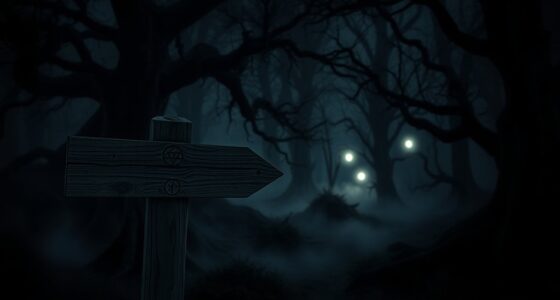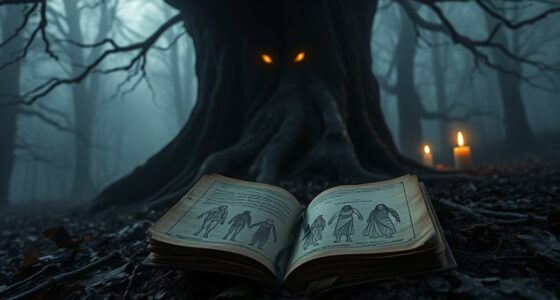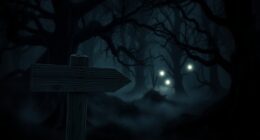If you’re looking for an intriguing paranormal topic, why not explore the enigma of shadow people? These dark figures often lurk in your peripheral vision, invoking feelings of dread and sparking diverse theories about their existence. From cultural interpretations as malevolent spirits to scientific explanations rooted in the brain’s visual processing, there’s so much to uncover. Stick around, and you’ll find out much more about this chilling phenomenon and what it might mean for you.
Key Takeaways
- Explore the cultural significance of ghosts, focusing on rituals and beliefs surrounding the afterlife in various societies.
- Investigate the rise of UFOs and UAPs, emphasizing recent military encounters and public interest in extraterrestrial phenomena.
- Delve into the world of cryptids, examining popular sightings and the community’s ongoing efforts in cryptozoology.
- Discuss near-death experiences, highlighting common themes and their impact on spirituality and perceptions of life and death.
- Examine the intriguing concept of time travel, including theories, anecdotal experiences, and cultural influences in media and literature.
Exploring the Enigma of Shadow People

Have you ever caught a glimpse of a dark figure flitting by in your peripheral vision? Those fleeting moments might just be encounters with shadow people.
Often described as shadowy figures, they tend to evoke feelings of dread or fear, especially during sleep paralysis or in dimly lit spaces. Theories about shadow people range from them being manifestations of negative energy to interdimensional beings or even psychological projections.
Shadow people, often perceived as dark figures, evoke dread and fear, particularly during sleep paralysis or in dimly lit environments.
Cultural interpretations vary widely; some see them as malevolent spirits or omens, while others view them as harmless figments of imagination.
Scientific explanations suggest that these experiences might stem from the brain’s interpretation of visual stimuli, creating illusions in low light.
Whatever the truth, shadow people remain an intriguing enigma.
The Allure of Ghosts and Their Cultural Significance

When you think about ghosts, you tap into a rich tapestry of global beliefs and stories that shape how societies view death and the afterlife.
Ghost hunting’s popularity reflects your curiosity about these spirits and their cultural significance in our lives.
As you explore this fascination, consider how these narratives influence your understanding of fear, loss, and the unknown.
Global Ghost Beliefs
Ghosts capture our imagination across cultures, embodying beliefs about the afterlife and the spirits of the deceased. Global ghost beliefs showcase diverse interpretations of the existence of ghosts, influencing rituals and traditions.
- In China and Japan, ancestral spirits are honored during festivals like Qingming and Obon.
- The Day of the Dead in Mexico celebrates deceased loved ones, showcasing a unique acceptance of death.
- Western folklore features ghost stories like the Headless Horseman, reflecting cultural fears and fascinations.
- Many cultures view ghosts as protectors, while others see them as malevolent entities.
These beliefs not only shape cultural identities but also influence how societies cope with loss and remember those who’ve passed. Additionally, the emotional toll of online cheating can parallel the grief experienced in the loss of loved ones, highlighting the complex ways societies process attachment and betrayal.
Ghost Hunting Popularity
As you explore the world of ghost hunting, you’ll find that the fascination with these ethereal beings is more than just a passing trend; it’s a cultural phenomenon that resonates deeply across various societies.
Ghosts captivate people as they symbolize connection, closure, or even unfinished business. This allure is evident in the explosion of ghost hunting shows that dominate media, drawing in vast audiences.
Social media platforms like TikTok have further fueled this interest, inspiring a new generation to engage in paranormal investigations and share their experiences.
Additionally, ghost hunting events and tours thrive as enthusiasts seek to explore haunted locations, blending historical narratives with ghost stories to deepen their connection to the past.
These experiences often encourage participants to reflect on their own spiritual journeys and the significance of unresolved emotions, enhancing their understanding of the connection between the physical and spiritual realms.
Cultural Impact on Society
The fascination with ghosts extends beyond mere entertainment; it reflects deep cultural threads woven into the fabric of society.
You’ll find that ghosts play a significant role in folklore worldwide, with varied meanings, from protective spirits to vengeful apparitions. This cultural intrigue drives public interest in paranormal activity, especially through popular ghost hunting shows.
Consider these aspects of ghost lore:
- Ghosts as ancestral spirits, honoring familial connections
- Rituals performed to appease spirits, showcasing cultural values
- Ghost stories helping people confront mortality
- Influence on societal behaviors, like avoiding haunted places
The allure of ghosts serves as a lens through which you can explore human curiosity about life, death, and the mysteries that lie beyond.
Unraveling the Mysteries of UFOs and UAPs

What makes UFOs and UAPs so fascinating? The recent surge in attention surrounding these phenomena, especially after military footage was released, has sparked curiosity.
The term UAP, which broadens the scope beyond traditional UFOs, helps reduce stigma around sightings. As the U.S. Department of Defense continues investigations, the focus shifts to understanding these encounters and their implications for national security.
Public interest is booming, with documentaries and media coverage shining a light on both historical and contemporary sightings. Meanwhile, the scientific community is stepping up, advocating for rigorous data collection and analysis to explore the origins of UAPs.
This open dialogue about UFOs and the possibility of extraterrestrial life is enthralling, and the mysteries are far from solved.
The Fascination With Cryptids: Bigfoot and Beyond
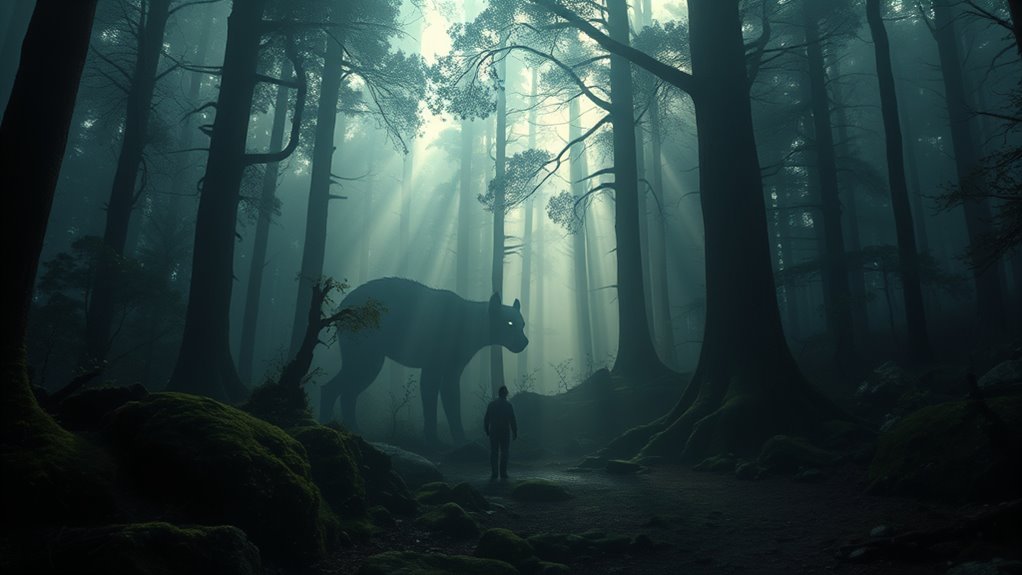
While many dismiss cryptids as mere folklore, the allure of creatures like Bigfoot and the Loch Ness Monster continues to captivate our imagination. You’re not alone if you find yourself drawn to the mystery surrounding these elusive beings.
The fascination often stems from the thrill of adventure and the unknown, leading to:
- A growing interest in cryptozoology, where enthusiasts investigate sightings.
- The rise of cryptid-themed festivals celebrating these legendary beings.
- An influx of documentaries exploring evidence and theories.
- Social media platforms where you can share encounters and findings.
Despite lacking scientific validation, cryptids like Mothman and Sasquatch spark curiosity and debate, showcasing our deep-rooted connection to myth-making and cultural beliefs.
Who knows what else might be lurking in the shadows?
Understanding Psychic Powers and Their Implications
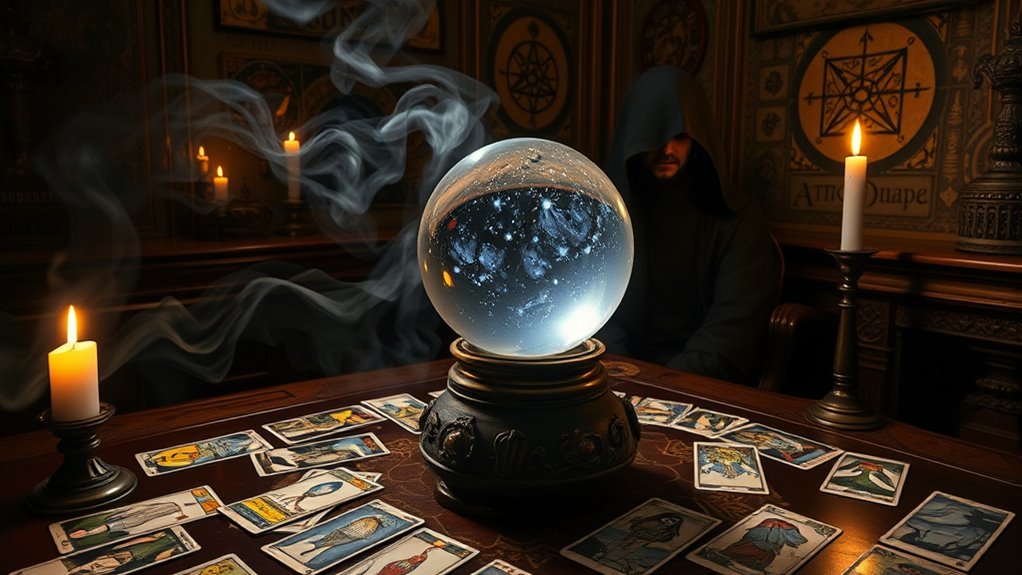
How do psychic powers influence our understanding of reality? They challenge the boundaries of what we consider possible, prompting both fascination and skepticism.
Abilities like telepathy, precognition, and psychokinesis have intrigued cultures for centuries, leading to studies by research institutions such as the Stanford Research Institute. Notable figures, like Uri Geller, have sparked scientific inquiry into these claims.
Today, social media fuels public interest, creating a vibrant community of individuals sharing their experiences. Within this field, you’ll find mediums, clairvoyants, and energy healers, each offering unique insights.
However, skepticism persists among scientists, many attributing these experiences to psychological factors. Paranormal investigators continue to explore these phenomena, seeking to bridge the gap between belief and evidence in our understanding of reality.
Investigating Near Death Experiences and Their Impact

Psychic powers challenge our perceptions of reality, and near-death experiences (NDEs) take this exploration even further.
Psychic phenomena push the boundaries of our understanding, while near-death experiences delve deeper into the mysteries of existence.
You might find it fascinating that about 10-20% of individuals who face clinical death report vivid sensations during their NDEs. These experiences can lead to profound changes in their lives.
Consider these key aspects of NDEs:
- A sense of detachment from the body
- Encounters with bright lights and deceased loved ones
- A life review revealing past actions and their impacts
- Changes in spirituality and fear of death
Research shows that NDEs often bring a greater appreciation for life and vary widely across cultural and religious contexts, highlighting their deeply subjective nature.
The World of Demonology: Distinguishing Demons From Ghosts
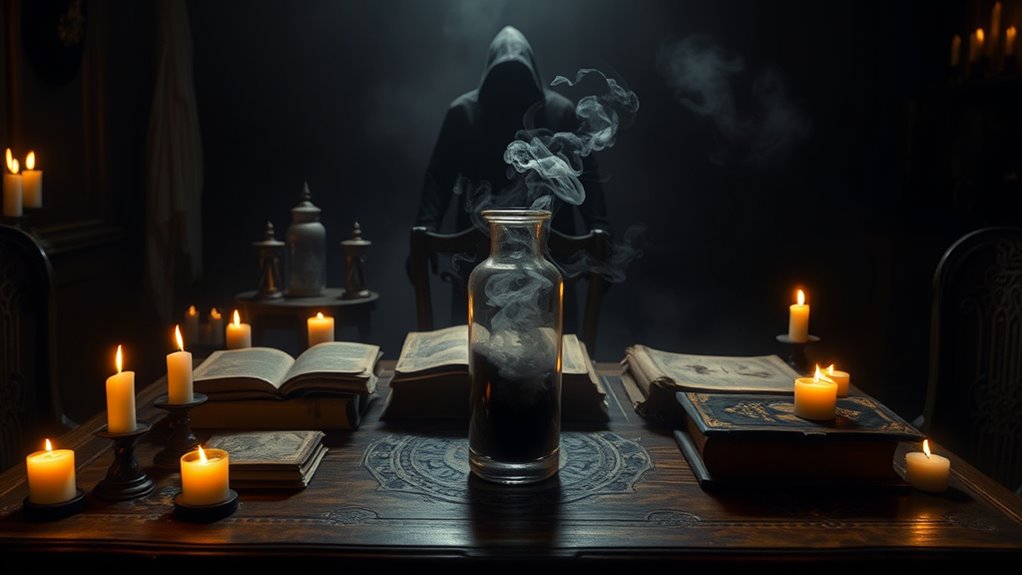
Demonology offers a fascinating lens through which to understand the supernatural, especially when distinguishing demons from ghosts.
While ghosts are often seen as spirits of deceased humans with residual energy or emotional ties, demons possess distinct personalities and intentions, usually associated with temptation and harm.
You might encounter demons in various cultural interpretations—some view them as fallen angels, while others see them as manifestations of psychological disturbances.
Exorcism, a key practice in demonology, aims to drive out these entities, requiring trained clergy or specialists.
This study intersects with religious beliefs, offering guidelines on confronting or protecting against demonic forces, emphasizing the spiritual implications of these encounters.
Recognizing these differences is essential for understanding the broader paranormal landscape.
The Science Behind Psychic Phenomena
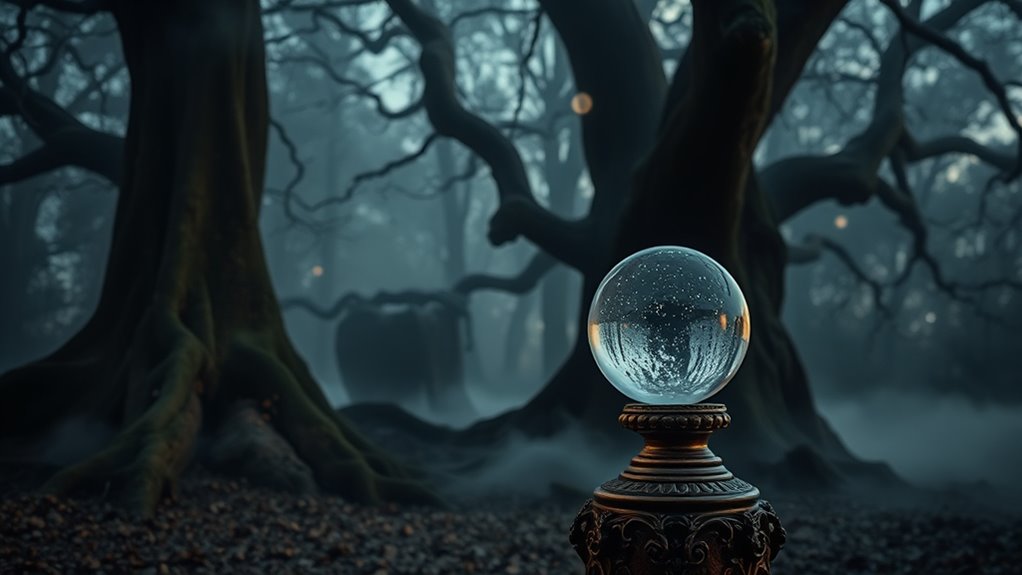
Understanding the nature of supernatural experiences can lead you to explore the domain of psychic phenomena, which has intrigued both believers and skeptics alike.
Research has attempted to quantify these abilities through controlled experiments and statistical methods, though skepticism often arises due to methodological issues.
Key points to evaluate include:
- Uri Geller’s telekinetic claims have been tested under strict conditions.
- The Ganzfeld experiment isolates participants to assess telepathy, yielding mixed results.
- Neuroimaging studies suggest brain regions, like the temporal lobes, may relate to psychic experiences.
- The concept of psi, or psychic energy, sparks ongoing debates about its existence.
Additionally, some researchers propose that certain essential oils for relaxation could enhance meditative practices, potentially fostering deeper psychic experiences.
Diving into these facets can deepen your understanding of psychic phenomena and its scientific implications.
Time Travel: Theories and Anecdotes
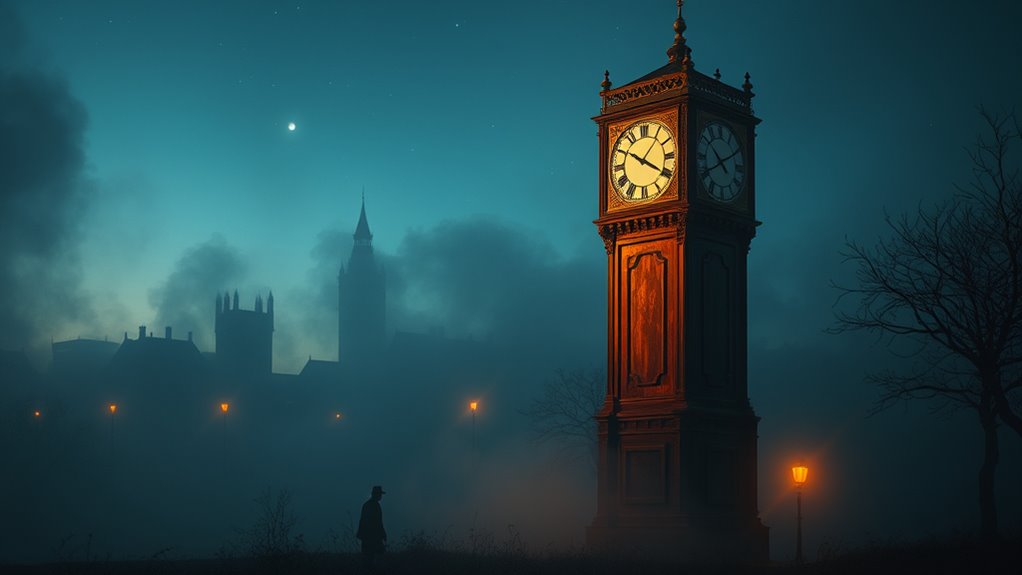
Time travel fascinates you, blending cutting-edge theories from physicists like Einstein with intriguing anecdotes from history.
Imagine experiencing a sudden shift to another time, like those reported in the 1950s Rugby time slip.
As we explore these theories and stories, you’ll see how they spark both excitement and debate about the nature of time itself.
Theories of Time Travel
While many people dream of traveling through time, the theories surrounding this fascinating concept often challenge our understanding of reality.
Einstein’s theory of relativity suggests time isn’t constant; it can be affected by speed and gravity. This opens the door to time travel under specific conditions.
Here are some intriguing theories:
- Wormholes: Theoretical passages through spacetime that could connect different points in time and space.
- Time Slips: Anecdotal experiences where individuals briefly find themselves in different eras.
- Grandfather Paradox: A dilemma questioning the consequences of altering the past, like preventing your own existence.
- Cultural Influence: Movies like “Back to the Future” shape our perceptions of time travel possibilities.
Exploring these theories fuels curiosity and imagination about time itself.
Notable Time Travel Anecdotes
As you explore the intriguing world of time travel anecdotes, you’ll find enthralling stories that blur the lines between reality and fiction.
One enthralling tale is that of John Titor, who claimed to be a time traveler from 2036, sharing detailed predictions online in the early 2000s. His accounts ignited debates about the possibilities of time travel.
Then, there are reports of “time slips,” where individuals find themselves momentarily in different eras, experiencing vivid details of their surroundings.
Historical figures like Charles Dickens even reported phenomena that seem to hint at time travel.
These anecdotes, combined with popular culture‘s fascination—like the adventures of Sam Beckett in “Quantum Leap”—keep the concept of time travel alive and endlessly enthralling.
Frequently Asked Questions
What Are the Topics for Supernatural Research Paper?
When you’re considering topics for a supernatural research paper, think about exploring the cultural significance of ghosts across different societies.
You might investigate the public’s growing interest in UFOs, especially after recent government disclosures. Cryptids like Bigfoot could also be fascinating, as could the study of psychic powers and notable cases.
Additionally, delving into phenomena like time travel and witchcraft can reveal their psychological impacts on individuals and cultures.
There’s plenty to explore!
Is There Any Proof of Paranormal?
You won’t find any solid proof of paranormal activity, like a ghost popping up on a TikTok video.
Most evidence relies on personal stories and subjective experiences, which can be influenced by your own mind. Investigators use tools like EMF meters, but these just measure regular environmental phenomena.
Plus, many spooky experiences can often be explained by psychology or environmental factors. Without reproducible results, skepticism in the scientific community remains strong.
What’s the Difference Between Paranormal and Supernatural?
You’ll find that the paranormal refers to phenomena beyond scientific explanation, like ghosts or unexplained sightings.
In contrast, the supernatural involves divine or spiritual elements, such as miracles or deities.
While paranormal experiences often focus on individual interpretations, supernatural events are tied to established belief systems.
Both domains can intersect, as people might attribute their paranormal experiences to supernatural causes based on their personal beliefs.
Understanding these distinctions enhances your exploration of these intriguing topics.
What Are the Different Types of Paranormal Spirits?
Have you ever wondered what types of paranormal spirits exist? You’ve got ghosts, which are often spirits of the deceased.
Poltergeists, on the other hand, create chaos with their physical disturbances.
Then there are residual spirits, stuck in loops of past events.
Elementals represent nature’s forces, each with distinct personalities.
Finally, demonic entities are malevolent, often needing rituals for removal.
Each type adds a unique layer to the paranormal world you explore.
Conclusion
As you immerse yourself in these enchanting topics, you’ll find that the paranormal world is like a vintage record player, spinning tales that resonate through time. Whether it’s the allure of ghosts or the mysteries of UFOs, each subject invites you to explore the unknown. By examining these phenomena, you not only satisfy your curiosity but also connect with humanity’s age-old quest for understanding. So, which mystery will you uncover next? The journey awaits!




